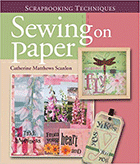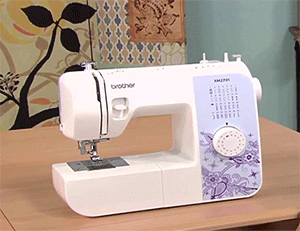 I am always looking for new ways to use my sewing machine. I like…no, I love making things myself. For years I’ve grown and dried flowers to mount on heavy paper stock to make my own special greeting cards for friends and family. Enter the scrap-booking era with its abundance of beautiful, decorative paper and I’ve found a whole new use for my sewing machine. Yes, I’m sewing on paper!
I am always looking for new ways to use my sewing machine. I like…no, I love making things myself. For years I’ve grown and dried flowers to mount on heavy paper stock to make my own special greeting cards for friends and family. Enter the scrap-booking era with its abundance of beautiful, decorative paper and I’ve found a whole new use for my sewing machine. Yes, I’m sewing on paper!
You might think it sounds a little odd at first. I remember when I first heard about this I asked myself, “Why would I want to sew on paper?” The answer is simple because it adds a special, more personal touch to my projects. Imagine a scrapbook page with a patchwork of gorgeous papers. Add decorative top stitches and you turn those bits of paper into a pretty quilt.
Want to add stitches but don’t want to pull out your sewing machine? Think about it. If you have ever done any embroidery by hand you know how wrinkled the fabric outside the hoop gets. It is very difficult to sew on anything by hand without leaving it wrinkled. This may not hold true for something small like a greeting card, but you might ruin a scrapbook page if you try to do too much sewing by hand. Go ahead and pull out that machine!
If you’d like to try your hand at sewing on paper, there are a few tips you should keep in mind:
- Longer stitches work best. Have you ever sewn short stitches on a delicate fabric just to have the fabric tear as if it were perforated? This can happen on paper with a disastrous result. Keep your stitches long and your project will remain secure.
- Separate needles for paper and fabric. Set aside needles just for use on paper. Sewing on paper will dull your needles more quickly than sewing on fabric. You will want to change your needles out before taking up a cloth project again. Use a permanent marker and make an obvious mark on the needles you will use just for sewing on paper.
- Don’t use your sewing shears on paper. Like needles, your sewing shears will dull if used on paper. Keep a separate pair of scissors in your kit to cut paper.
- Clean your machine! Many of us clean our sewing machines on a regular basis. Sewing on paper produces more dust than sewing on most fabrics. Some papers will be worse than others. You will need to check your machine more often to make sure the paper dust isn’t building up inside your machine.
- Don’t sew in reverse to lock in your stitches. Remember earlier what I said about keeping your stitches long? The same tears can happen if you stitch over an area twice like you would by stitching in reverse. You can secure loose threads on the back of your project with tape or glue, but make sure you use adhesives made specifically for archival use so they won’t discolor your paper over time. If you don’t want the back side of your sewing to show as it would on a greeting card, just cut a piece of card stock and use glue or double-sided tape to mount it over the back of the stitching.
- Talking about adhesives…don’t sew through them! If you think the additional dust is bad for your sewing machine, just wait until it gets gummed up with the adhesives from tape, glue and paste. If you know you are going to sew around the edges of paper, use adhesives in the center portion of the paper. The stitches will hold the edges down just fine.
- Machine sewing is the best way to attach fiber trims to paper. Is that beautiful scrapbook page falling apart? Is the fringe, ribbon or trim coming unglued each time you add something else to the page or card? Sew it on and those beautiful trims will stay where you put them the first time.
Sewing on paper has opened up a sewing basket full of ideas for my hand made greeting cards. I was one of those people who used glue for fabric trims and then crossed my fingers the glue would hold long enough for the recipient to actually open the envelope and enjoy the sentiment held inside.
Do you have other ideas for sewing on paper? Please share some of them in the comments below. We look forward to hearing from you.
These items might help you get started on some projects:
Scrapbooking techniques: Sewing on Paper
“Award-winning watercolor artist Catherine Matthews Scanlon reveals the secrets of using hand sewing, embroidery, and machine stitching to enhance scrapbooks, greeting cards, tags, and memory books. It’s a fun, easy way to create interesting elements and textures, and all the basics for completing colorful projects are beautifully explained: which tools to use, what fibers and threads work best, and how to master the various stitching techniques.”
Paper Quilting: Creative Designs Using Paper and Thread
This very highly rated book includes 25 projects fully illustrated with color photography. It is a must-have for the paper artists and quilters alike.





